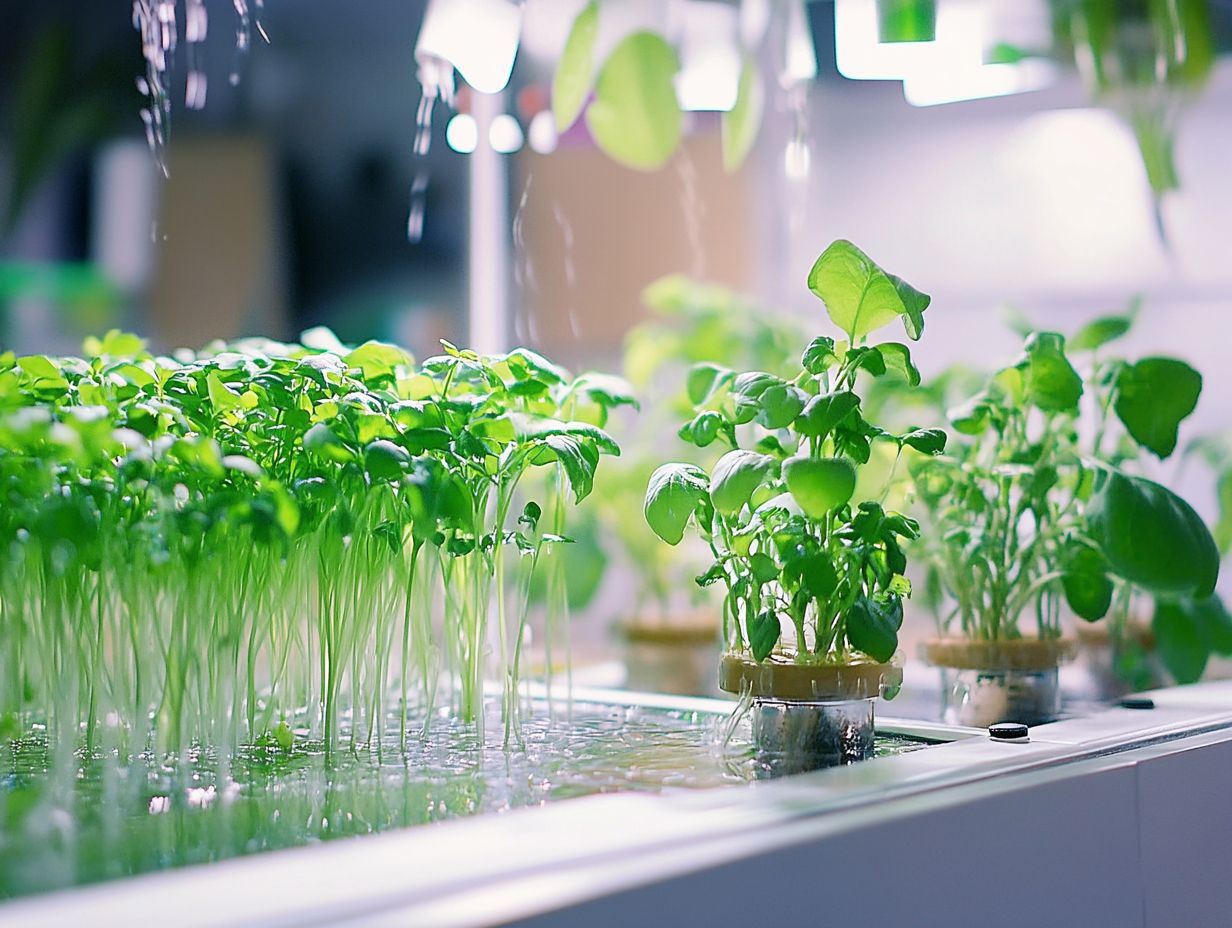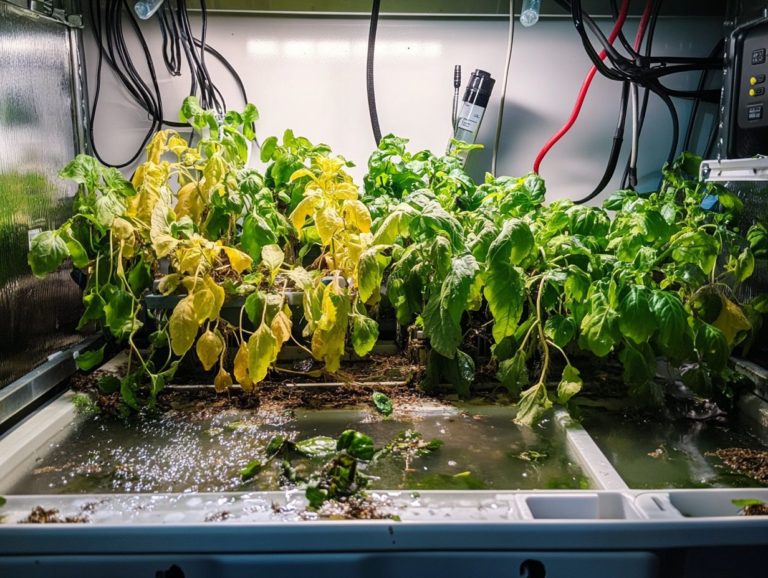How to Balance Oxygen Levels in Hydroponics
Oxygen is essential for the growth and health of plants, especially in hydroponic systems where nutrient delivery relies on both water and air. Techniques like NFT and the Kratky Method benefit from optimal oxygen levels.
By effectively managing oxygen levels, you can enhance plant development and increase your yields significantly.
This article explores the crucial role of oxygen for plants, the factors that influence oxygen levels, and effective methods for measuring and adjusting those levels.
You ll discover techniques to boost oxygenation, such as using air stones and pumps, as well as common pitfalls to avoid to ensure your hydroponic garden flourishes.
Contents
- Key Takeaways:
- Understanding Oxygen Levels in Hydroponics
- Measuring Oxygen Levels in Hydroponics
- Ways to Increase Oxygen Levels in Hydroponics
- Maintaining Balanced Oxygen Levels in Hydroponics
- Frequently Asked Questions
- What is the ideal oxygen level for hydroponic plants?
- How can I test the oxygen levels in my hydroponic system?
- Why is it important to balance oxygen levels in hydroponics?
- How can I increase oxygen levels in my hydroponic system?
- Can high oxygen levels be harmful to hydroponic plants?
- Are there any natural ways to balance oxygen levels in hydroponics?
Key Takeaways:

- Oxygen is crucial for healthy plant growth in hydroponic systems.
- Techniques like dissolved oxygen meters and air stones monitor and boost oxygen levels.
- Regular monitoring and proper techniques are necessary to prevent root rot.
Understanding Oxygen Levels in Hydroponics
Understanding the importance of oxygen levels in hydroponics is key to fostering optimal plant growth and healthy roots. Oxygen directly influences nutrient uptake and the overall health of the root system.
In a hydroponic setup, maintaining the right balance of dissolved oxygen the oxygen mixed with water is vital for plants to absorb essential nutrients. This promotes robust growth and helps prevent issues like root rot.
Importance of Oxygen for Plant Growth
Oxygen is fundamental for your plants growth. It directly affects photosynthesis, oxygen absorption, and nutrient uptake, contributing to healthy growth and vibrant foliage.
This vital element plays a key role in respiration, where plants convert nutrients into energy. The availability of oxygen in the root system is crucial for efficiently absorbing essential minerals.
Maintaining optimal oxygen levels allows for strong root development and overall plant vitality, enabling plants to withstand environmental stressors.
Factors Affecting Oxygen Levels in Hydroponics
Several factors impact oxygen levels in your hydroponic system, including temperature, water movement, and the specific nutrient solution composition. These factors influence the dissolved oxygen available to your plants.
Understanding the interaction of these elements is crucial. For instance, high temperatures can decrease the solubility of oxygen, reducing its availability for roots. If water movement is inadequate, air circulation may be compromised, hindering nutrient absorption.
The nutrient solution composition is also important; certain formulations require specific oxygen saturation levels for optimal growth, especially for crops like tomatoes and herbs. For more insights on maintaining proper conditions, including troubleshooting pH levels in hydroponic gardens, managing these factors carefully can ensure healthier plants and reduce the risk of low oxygen-related complications.
Measuring Oxygen Levels in Hydroponics
Measuring oxygen levels in hydroponics is crucial for maintaining optimal growth conditions. By implementing effective methods, you can ensure that your plants receive enough dissolved oxygen, enhancing their health and productivity.
Discover how to create the perfect environment for your plants to thrive and reach their fullest potential!
Methods for Measuring Oxygen Levels

You have several effective methods for measuring oxygen levels in hydroponics. These include devices that measure oxygen in water, air diffusers, and air pumps. These tools provide precise readings essential for optimizing plant growth.
These measurement techniques are vital for ensuring your hydroponically grown plants receive adequate oxygen. This is crucial for their respiration and overall vitality.
Devices that measure oxygen in water stand out for their ability to quantify oxygen concentration in nutrient solutions. They allow you to monitor levels in real-time and adjust aeration as needed.
Air diffusers enhance oxygenation by introducing fine bubbles into the water, promoting better gas exchange. Understanding the significance of these methods will help you prevent root decay and maximize nutrient uptake.
This knowledge leads to healthier plants and more abundant yields in your hydroponic system.
Interpreting Results and Ideal Oxygen Levels
Interpreting oxygen level results in hydroponics is essential for creating ideal conditions for plant growth. It also helps you understand the needs of different crops.
In hydroponic systems, ideal oxygen levels typically range between 5 to 8 mg/L. This range facilitates efficient nutrient uptake and promotes robust root development.
Most plants thrive when oxygen is abundant, as it enhances cellular respiration the process plants use to convert food into energy and supports vital metabolic processes for growth.
However, when oxygen levels fall below this range, you’ll likely notice signs of stress in your plants. These signs include slowed growth and nutrient deficiencies.
Keep an eye on these levels for thriving, happy plants! By regularly monitoring, you can cater to the specific needs of different species, like herbs and tomatoes, ensuring conditions remain optimal for peak performance.
This diligence ultimately leads to a flourishing crop and maximizes your potential for harvest.
Ways to Increase Oxygen Levels in Hydroponics
You have several effective strategies to elevate oxygen levels in hydroponics. These include using air pumps and microbubble systems.
Employing advanced oxygenation techniques, such as air pumps and diffusers, enriches the nutrient solution. This ensures optimal growth conditions for your plants.
Techniques for Oxygenation
Utilizing oxygenation techniques like air stones and air pumps can significantly enhance oxygen levels in your hydroponic system. This promotes healthier roots and fosters robust plant growth.
These methods enrich your nutrient solution and create a balanced environment that supports beneficial microorganisms, crucial for maintaining plant health.
By ensuring that your plants roots receive adequate oxygen, you can reduce the risk of common issues like root rot, which often occurs in stagnant conditions.
Consider integrating microbubble systems into your setup. They deliver tiny air bubbles that enhance gas exchange at the root level.
This increased oxygen availability boosts nutrient uptake, resulting in stronger, healthier plants. Ultimately, this leads to a more abundant harvest while minimizing the need for chemical interventions.
Choosing the Right Oxygenation Method for Your Setup
Choosing the right oxygenation method for your hydroponics setup is crucial for crop cultivation.
Different systems like air diffusers, air pumps, and aeroponic systems vary in efficiency and suitability.
The techniques you select can impact the growth rate and health of your plants significantly.
For example, air diffusers can boost oxygen levels in your nutrient solutions.
It’s essential to evaluate your hydroponic system’s needs carefully, considering factors such as water temperature, plant type, and growth stage.
Striking the right balance between airflow and moisture levels is vital for optimal root respiration.
By understanding the pros and cons of each method, you can foster more robust growth and increased yield.
Incorporate features like airstones or specialized tubing to further optimize oxygen delivery, creating the perfect environment for your plants to thrive.
Maintaining Balanced Oxygen Levels in Hydroponics

Maintaining balanced oxygen levels in hydroponics is essential, requiring regular monitoring and adjustments to prevent root rot and other issues.
This diligence ensures that your plants receive the optimal conditions vital for their growth and health.
Any imbalances could lead to serious issues, such as root rot and the proliferation of harmful bacteria.
Regular Monitoring and Adjustments
Regular monitoring of oxygen levels in your hydroponic system is essential for fostering robust growth.
By making timely adjustments, you can avert conditions that could lead to root rot or other undesirable effects.
To ensure your plants thrive, utilize dissolved oxygen (DO) meters for precise readings of the oxygen levels in your nutrient solutions.
By consistently checking these metrics, you can spot trends and make informed adjustments that benefit your crops.
Incorporate an aeration system think air stones, air pumps, or diffusers to enhance oxygen saturation.
This creates a healthier environment for your roots.
By considering the specific oxygen needs of different crops, you can fine-tune your practices, ensuring that each plant receives the tailored care it requires for vibrant, flourishing growth.
Common Mistakes to Avoid
Avoiding common mistakes in managing oxygen levels in hydroponics is essential.
Negligence can lead to problems like root rot and stunted growth.
Understanding the balance of oxygen availability is vital for providing your plants with the optimal conditions they need to thrive.
One frequent misstep is relying on inadequate aeration systems; this can limit root access to sufficient oxygen, resulting in sluggish growth.
If you’re not vigilant about regular monitoring, this issue can worsen, making it harder to detect and correct low oxygen levels.
To enhance oxygen distribution in your nutrient solution, consider using high-quality air pumps and incorporating air stones to create bubbles.
By prioritizing these practices, you can sidestep potential setbacks and foster healthier, more productive plants.
Frequently Asked Questions
What is the ideal oxygen level for hydroponic plants?
The ideal oxygen level for hydroponic plants is between 5-8 ppm (parts per million). This range provides sufficient oxygen for respiration.
How can I test the oxygen levels in my hydroponic system?

There are several ways to test oxygen levels in a hydroponic system, including using a dissolved oxygen meter, oxygen test strips, or an oxygen sensor probe.
These tools can provide accurate readings to help you monitor and adjust your oxygen levels.
Ready to enhance your hydroponics? Start optimizing your oxygen levels today!
Why is it important to balance oxygen levels in hydroponics?
Balancing oxygen levels in hydroponics is crucial for plant health and growth. Plants need oxygen to survive and thrive.
A lack of oxygen can lead to root rot and stunted growth. By maintaining proper oxygen levels, you can ensure that your plants have the necessary resources to flourish.
How can I increase oxygen levels in my hydroponic system?
There are several ways to increase oxygen levels in a hydroponic system. One method is to use an air stone or diffuser to introduce more oxygen into the water.
You can also decrease the water temperature since cold water holds more dissolved oxygen. Regularly changing the water and preventing clogs helps improve oxygen levels too!
Can high oxygen levels be harmful to hydroponic plants?
Plants need oxygen, but too much can be harmful. Oxygen levels above 8 parts per million (ppm) can cause the roots to become oversaturated.
This can lead to root damage or death. Keep a close eye on your oxygen levels for healthy plants!
Are there any natural ways to balance oxygen levels in hydroponics?
Yes, there are natural ways to balance oxygen levels in hydroponics. Using aquatic plants like water lettuce or water hyacinth can help.
These plants absorb excess nutrients and release oxygen through photosynthesis. Regularly adding fresh, clean water also helps regulate oxygen levels.






